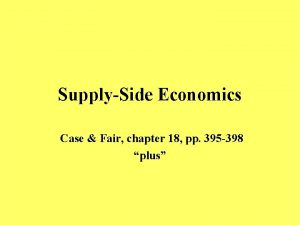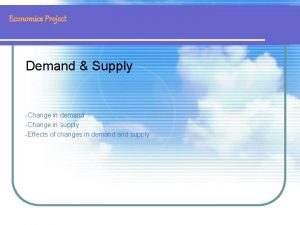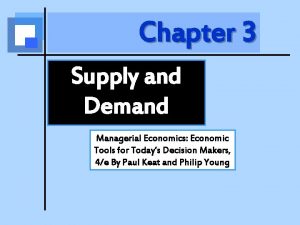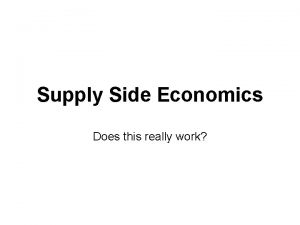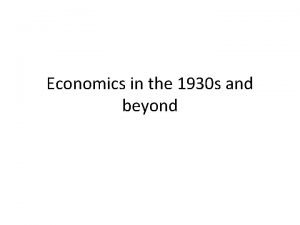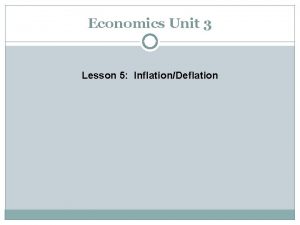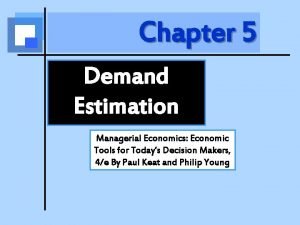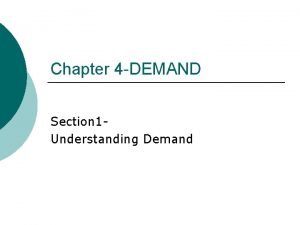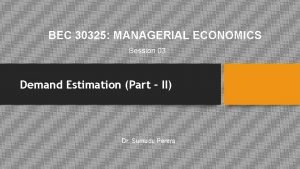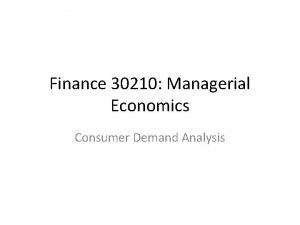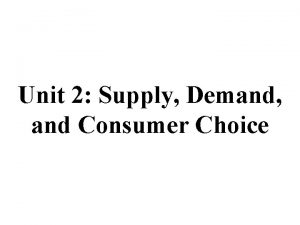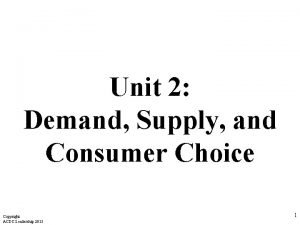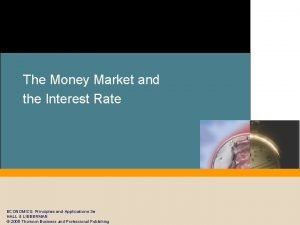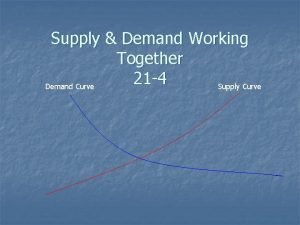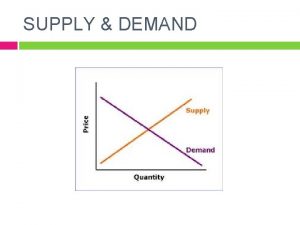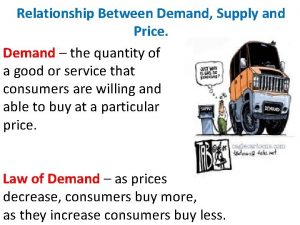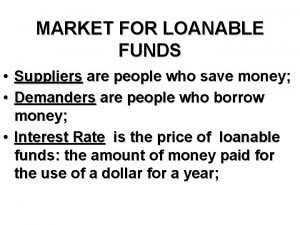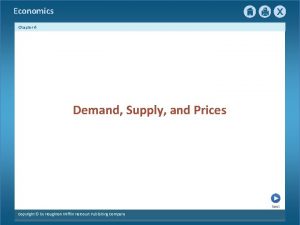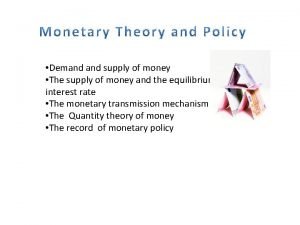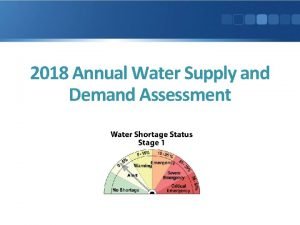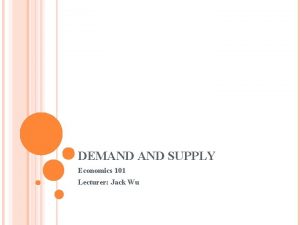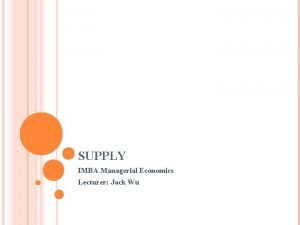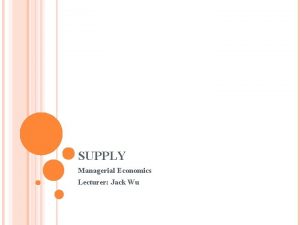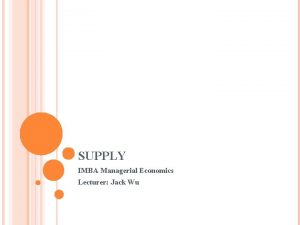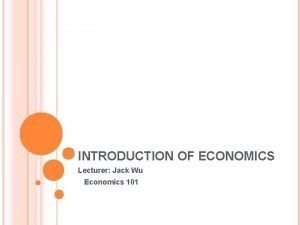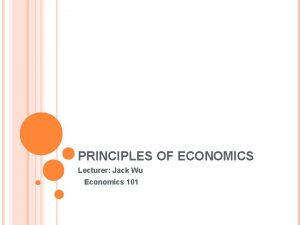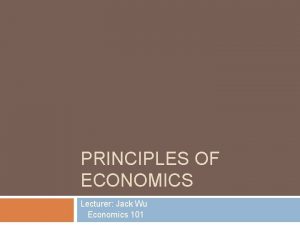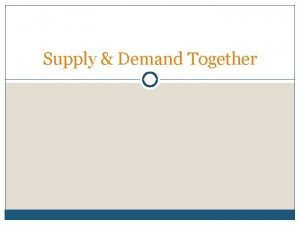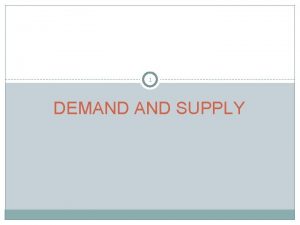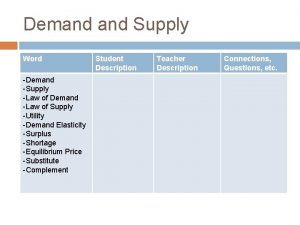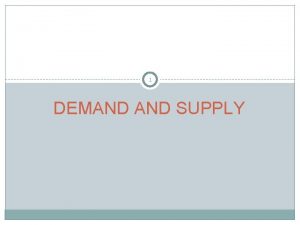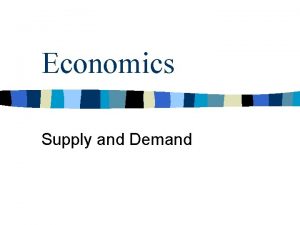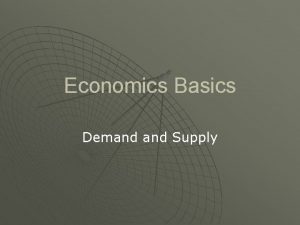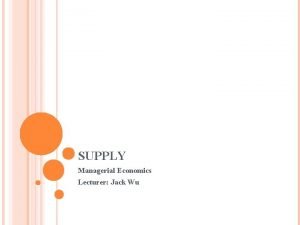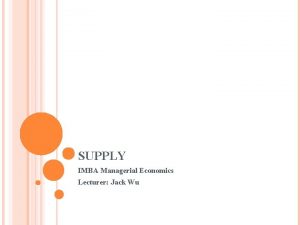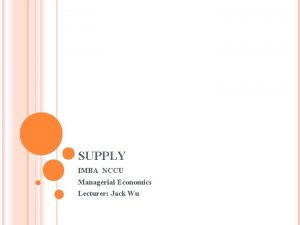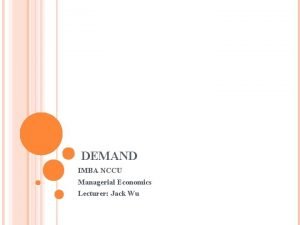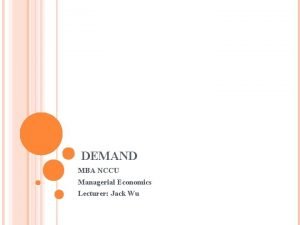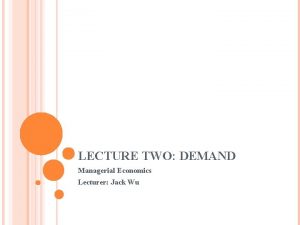DEMAND SUPPLY Economics 101 Lecturer Jack Wu DEMAND























































- Slides: 55

DEMAND SUPPLY Economics 101 Lecturer: Jack Wu

DEMAND SUPPLY Demand supply are the two words that economists use most often. Demand supply are the forces that make market economies work. Modern microeconomics is about supply, demand, and market equilibrium.

MARKET A market is a group of buyers and sellers of a particular good or service. Buyers determine demand. Sellers determine supply

COMPETITIVE MARKET A competitive market is a market in which there are many buyers and sellers so that each has a negligible impact on the market price.

PERFECT COMPETITION Products are the same Numerous buyers and sellers so that each has no influence over price Buyers and Sellers are price takers

NO COMPETITION Monopoly: One seller, and seller controls price Monopsony: One buyer, and buyer controls price

IMPERFECT COMPETITION Oligopoly Few sellers Not always aggressive competition Monopolistic Competition Many sellers Slightly differentiated products Each seller may set price for its own product

DEMAND Quantity demanded is the amount of a good that buyers are willing and able to purchase. Law of Demand The law of demand states that, other things equal, the quantity demanded of a good falls when the price of the good rises.

DEMAND SCHEDULE Demand Schedule The demand schedule is a table that shows the relationship between the price of the good and the quantity demanded.

EXAMPLE OF DEMAND SCHEDULE Price ($ per movie) 10. 00 7. 50 5. 00 2. 50 0. 00 Quantity (movies per month) 0 1 2 4 7

DEMAND CURVE Demand Curve The demand curve is a graph of the relationship between the price of a good and the quantity demanded.

INDIVIDUAL DEMAND CURVE Price ($ per movie) 10 7. 50 individual demand curve 5 2. 50 0 1 2 4 Quantity (Movies a month) 7

TWO VIEWS for every possible price, it shows the quantity demanded for each unit of item, it shows the maximum price that the buyer is willing to pay

ANOTHER EXAMPLE OF DEMAND SCHEDULE

ANOTHER WAY OF DEMAND CURVE Price of Ice-Cream Cone $3. 00 2. 50 1. A decrease in price. . . 2. 00 1. 50 1. 00 0. 50 0 1 2 3 4 5 6 7 8 9 10 11 12 Quantity of Ice-Cream Cones 2. . increases quantity of cones demanded. Copyright © 2004 South-Western

NEGATIVE PRICE? A negative price case: Hoover’s special promotion -- two free air tickets (worth more than £ 400) for purchase of appliance over £ 100. q q promotion attracted over 100, 000 customers Hoover incurred £ 48 million loss

CETERIS PARIBUS When a demand curve is drawn, everything but price and quantity demanded is held constant. Definition: a Latin phrase, translated as “other things being equal”.

MARKET DEMAND Market demand refers to the sum of all individual demands for a particular good or service. Graphically, individual demand curves are summed horizontally to obtain the market demand curve.

CHANGE IN QUANTITY DEMANDED Change in Quantity Demanded Movement along the demand curve. Caused by a change in the price of the product.

CHANGES IN QUANTITY DEMANDED Price of Ice. Cream Cones B $2. 00 A tax that raises the price of ice-cream cones results in a movement along the demand curve. A 1. 00 D 0 4 8 Quantity of Ice-Cream Cones

CHANGE IN DEMAND Change in Demand A shift in the demand curve, either to the left or right. Caused by any change that alters the quantity demanded at every price.

CHANGE IN DEMAND Price of Ice-Cream Cone Increase in demand Demand curve, D 3 0 Demand curve, D 1 Demand curve, D 2 Quantity of Ice-Cream Cones Copyright© 2003 Southwestern/Thomson Learning

SHIFT IN THE DEMAND CURVE Consumer income Prices of related goods Tastes Expectations Number of buyers

DEMAND INCOME Changes in income normal good – demand increases with income inferior good – demand falls with income -- example: potato

INFERIOR GOOD V. S. BADS Inferior good is different from “bads”. Examples of “bads”: pollution or garbage

DEMAND PRICES OF RELATED GOODS Prices of Related Goods When a fall in the price of one good reduces the demand for another good, the two goods are called substitutes. When a fall in the price of one good increases the demand for another good, the two goods are called complements.

CASE STUDY Two ways to reduce the quantity of smoking demanded: -- Public service announcements, mandatory health warnings on cigarette packages, and the prohibition of cigarette advertising on TV (shift demand curve) -- Raising the price of cigarettes through tobacco taxes (move along demand curve)

SUMMARY variable change Demand Shift Income (Normal) Rise (fall) Right (left) Income (Inferior) Rise (fall) Fall (rise) Left (right) Price of substitute Rise (fall) Right (left) Price of complement Rise (fall) Fall (rise) Left (right) Taste Rise (fall) Right (left) Expected Price Rise (fall) Right (left) Number of buyers Rise (fall) Right (left)

SUPPLY Quantity supplied is the amount of a good that sellers are willing and able to sell. Law of Supply The law of supply states that, other things equal, the quantity supplied of a good rises when the price of the good rises.

SUPPLY SCHEDULE Supply Schedule The supply schedule is a table that shows the relationship between the price of the good and the quantity supplied.

EXAMPLE OF SUPPLY SCHEDULE

SUPPLY CURVE Supply Curve The supply curve is the graph of the relationship between the price of a good and the quantity supplied.

Price of Ice-Cream Cone $3. 00 1. An increase in price. . . 2. 50 2. 00 1. 50 1. 00 0. 50 0 1 2 3 4 5 6 7 8 9 10 11 12 Quantity of Ice-Cream Cones 2. . increases quantity of cones supplied. Copyright© 2003 Southwestern/Thomson Learning

TWO VIEWS For every possible price, it shows the production rate For each unit of item, it shows the minimum price that the seller is willing to accept

MARKET SUPPLY Market supply refers to the sum of all individual supplies for all sellers of a particular good or service. Graphically, individual supply curves are summed horizontally to obtain the market supply curve.

CHANGE IN QUANTITY SUPPLIED Change in Quantity Supplied Movement along the supply curve. Caused by a change in price.

CHANGE IN QUANTITY SUPPLIED Price of Ice. Cream Cone S C $3. 00 A rise in the price of ice cream cones results in a movement along the supply curve. A 1. 00 0 1 5 Quantity of Ice-Cream Cones

CHANGE IN SUPPLY Change in Supply A shift in the supply curve, either to the left or right. Caused by a change in a determinant other than price.

FIGURE 7 SHIFTS IN THE SUPPLY CURVE Price of Ice-Cream Cone Supply curve, S 3 Decrease in supply Supply curve, S 1 Supply curve, S 2 Increase in supply 0 Quantity of Ice-Cream Cones Copyright© 2003 Southwestern/Thomson Learning

SHIFT IN THE SUPPLY CURVE Input prices Technology Expectations Number of sellers

SUMMARY variable change Supply Shift Input (factor) price Technology Rise (fall) Fall (rise) Left (right) Rise (fall) Right (left) Expected Price Number of sellers Rise (fall) Fall (rise) Left (right) Rise (fall) Right (left)

EQUILIBRIUM Equilibrium refers to a situation in which the price has reached the level where quantity supplied equals quantity demanded.

EQUILIBRIUM PRICE AND QUANTITY Equilibrium Price The price that balances quantity supplied and quantity demanded. On a graph, it is the price at which the supply and demand curves intersect. Equilibrium Quantity The quantity supplied and the quantity demanded at the equilibrium price. On a graph it is the quantity at which the supply and demand curves intersect.

Price of Ice-Cream Cone Supply Equilibrium price $2. 00 Equilibrium quantity 0 1 2 3 4 5 6 7 8 Demand 9 10 11 12 13 Quantity of Ice-Cream Cones Copyright© 2003 Southwestern/Thomson Learning

SURPLUS AND SHORTAGE Surplus When price > equilibrium price, then quantity supplied > quantity demanded. There is excess supply or a surplus. Suppliers will lower the price to increase sales, thereby moving toward equilibrium. Shortage When price < equilibrium price, then quantity demanded > the quantity supplied. There is excess demand or a shortage. Suppliers will raise the price due to too many buyers chasing too few goods, thereby moving toward equilibrium.

ALTERNATIVE EXAMPLE: #2 LEAD PENCILS Price Quantity demanded Quantity supplied 0. 05 1000 400 0. 10 800 500 0. 15 600 0. 20 400 700 0. 25 200 800

QUICK QUIZ 1 Draw demand supply curves Find equilibrium price and quantity

QUICK QUIZ 2 How would following events shift either the demand or the supply of #2 lead pencil? -- an increase in the use of standardized exams (using opscan forms) -- a decrease in the price of ink pens -- a start of a school year

INCREASE IN DEMAND Price of Ice-Cream Cone 1. Hot weather increases the demand for ice cream. . . Supply New equilibrium $2. 50 2. 00 2. . resulting in a higher price. . . Initial equilibrium D D 0 7 3. . and a higher quantity sold. 10 Quantity of Ice-Cream Cones Copyright© 2003 Southwestern/Thomson Learning

DECREASE IN SUPPLY Price of Ice-Cream Cone S 2 1. An increase in the price of sugar reduces the supply of ice cream. . . S 1 New equilibrium $2. 50 Initial equilibrium 2. 00 2. . resulting in a higher price of ice cream. . . Demand 0 4 7 3. . and a lower quantity sold. Quantity of Ice-Cream Cones Copyright© 2003 Southwestern/Thomson Learning

SUMMARY

DISCUSSION Each of the events listed below has an impact on the market for bicycles. 1. An increase in the price of automobile. 2. A decrease in incomes of consumers if bicycles are a normal good.

DISCUSSION-CONTINUED 3. An increase in the price of steel used to make bicycle frames. 4. An environmental movement shifts tastes toward bicycling.

DISCUSSION-CONTINUED 5. Consumers expect the price of bicycles to fall in the future. 6. A technological advance in the manufacture of bicycles.

DISCUSSION-CONTINUED 7. A reduction in the price of bicycle helmets and shoes. 8. A decrease in incomes of consumers if bicycles are an inferior good.
 Lecturer's name
Lecturer's name Supply vs demand side economics
Supply vs demand side economics Supply and demand economics project
Supply and demand economics project Supply and demand economics project
Supply and demand economics project Supply analysis in managerial economics
Supply analysis in managerial economics Matching supply and demand in supply chain
Matching supply and demand in supply chain Module 5 supply and demand introduction and demand
Module 5 supply and demand introduction and demand Describe jack from jack and the beanstalk
Describe jack from jack and the beanstalk Physician associate lecturer
Physician associate lecturer Spe distinguished lecturer
Spe distinguished lecturer Teacher good morning class
Teacher good morning class Photography lecturer
Photography lecturer Lecturer in charge
Lecturer in charge Designation lecturer
Designation lecturer Designation of lecturer
Designation of lecturer Why himalayan rivers are pernnial in nature
Why himalayan rivers are pernnial in nature Lecturer name
Lecturer name Pearson lecturer resources
Pearson lecturer resources 140000/120
140000/120 Lector vs lecturer
Lector vs lecturer Lecturer in charge
Lecturer in charge Cfa lecturer handbook
Cfa lecturer handbook Lecturer asad ali
Lecturer asad ali Maastricht university economics and business economics
Maastricht university economics and business economics Non mathematical economics
Non mathematical economics Supply curve economics
Supply curve economics Supply side economics
Supply side economics Monetarist vs classical economics
Monetarist vs classical economics Demand side economics
Demand side economics Demand forecasting and estimation
Demand forecasting and estimation Economics unit 3 lesson 1
Economics unit 3 lesson 1 Regression analysis in managerial economics
Regression analysis in managerial economics Economics chapter 4 section 1 understanding demand answers
Economics chapter 4 section 1 understanding demand answers Demand estimation in managerial economics
Demand estimation in managerial economics Managerial economics demand analysis
Managerial economics demand analysis Economics chapter 4 demand
Economics chapter 4 demand Chapter 5 section 1 supply and the law of supply
Chapter 5 section 1 supply and the law of supply Ang elastisidad ng supply ay?
Ang elastisidad ng supply ay? Unit 2 demand supply and consumer choice
Unit 2 demand supply and consumer choice Acdc copyright
Acdc copyright Unit 2 demand supply and consumer choice worksheet
Unit 2 demand supply and consumer choice worksheet Money market equilibrium
Money market equilibrium Combining supply and demand worksheet
Combining supply and demand worksheet Interaction of demand and supply
Interaction of demand and supply What is the relationship between supply and price
What is the relationship between supply and price Who are the suppliers of loanable funds
Who are the suppliers of loanable funds Loanable funds market demand shifters
Loanable funds market demand shifters Chapter 6 section 2 supply and demand in everyday life
Chapter 6 section 2 supply and demand in everyday life Halimbawa ng kurba ng demand
Halimbawa ng kurba ng demand Money supply curve
Money supply curve Supply demand rule
Supply demand rule Long run aggregate supply curve
Long run aggregate supply curve Long run aggregate supply curve
Long run aggregate supply curve Sras lras
Sras lras Aggregate demand supply graph
Aggregate demand supply graph Annual water supply and demand assessment
Annual water supply and demand assessment

